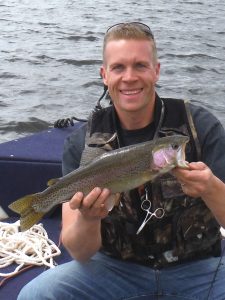Our Outdoors: Cornered
By Nick Simonson
“If the trout have been stocked, it’ll be fast and furious,” I explained to my buddy Adam, “if they’re not in the lake yet, the bites will be fewer, but the fish will all be big,” I concluded on our sort of all-or-nothing venture to a prairie impoundment known for its handful of big rainbows that managed to survive summer’s heat, winter’s low oxygen and all sorts of angling pressure on the small lake.
I readied a rod for our mission in the relative calm of a north bay just off the launch and kicked the trolling motor up to mid-power in order to hold against the rising gusts under partly cloudy skies. Foregoing the fly rod in the windy conditions, I tied on a jig and twister combo and began casting as the wind pushed us out of the creek arm and into the north lobe of the main lake. Dialing the troller down, we let the wind do most of the work as we drifted through the top half of the reservoir.
After about 15 minutes, neither of us had a strike, and I presumed we were a few days ahead of the annual stocking of the catchable-sized trout that kept the water an attractive draw for anglers looking for something different, or those out-of-place dedicated fly anglers that frequented the flow for their fix.
“It’ll be one of those ‘one big fish makes the day’ scenarios,” I related to my buddy as we drifted into the wind-pounded southern shoreline of the upper portion of the lake, before switching over to a light rod lined with four-pound monofilament.
Within five minutes we had both missed a strike, and knowing they’d come at a premium ahead of the hatchery-raised fish hitting the water, we doubled back on the spots and fired off a few extra casts before curling around the point that led to the deeper main lake basin. Protected by a large hill, we coasted slowly and watched the bottom drop on the sonar from 15, to 20, then to 30 feet and deeper. It was evident that there was more than enough space for the stocked fish to survive the warm summer stretches in July and August and enough room to hold comfortably until the recent release from winter’s icy bonds. Entering the calm arm of the southern rill that fed runoff into the lake, my buddy missed a second strike and we hit the deeper stretch of the section hard in hopes of connecting again.
 Looking back to the main lake, we watched the waves pick up and I suggested the best bet was the southeast corner which had been absorbing the brunt of the afternoon’s gusts. The near-whitecaps on the small body slammed against the boulders and rip-rap that shielded the large earthen dam that created the impoundment, and the foam and roiling water would provide some relief from the bright spring sun that was shining down to any remaining fish below. Turning again with the gales we coasted into the corner of the lake and I flipped the trolling motor back on high to hold our position.
Looking back to the main lake, we watched the waves pick up and I suggested the best bet was the southeast corner which had been absorbing the brunt of the afternoon’s gusts. The near-whitecaps on the small body slammed against the boulders and rip-rap that shielded the large earthen dam that created the impoundment, and the foam and roiling water would provide some relief from the bright spring sun that was shining down to any remaining fish below. Turning again with the gales we coasted into the corner of the lake and I flipped the trolling motor back on high to hold our position.
Firing out a cast toward the line where the dark, dam-side waters rose sharply into the thin gray shallows, I felt a click-click-click of something slide through the last three eyelets of my light rod. The gusting winds had double-wrapped the line being towed by the jig and twister on the way out of the reel, and a small bird’s nest was visible about ten feet behind the lure as it splashed down.
“Guaranteed to get a fish now,” I lamented out loud to my buddy, “a wind knot just formed when I casted,” I explained.
As sure as poop in the backyard of a three-dog family, I lifted the rod tip and a mighty strike ensued. I set the hook and light action rod doubled over and the fish charged at the boat. The run gave me a chance to gain line, and I watched it warily as I saw the small knot come closer and closer to the lead eyelet while I lightened the drag significantly to adjust for the compromised integrity of the tether. The runs of the fish pulled the three-loop flag back in the fish’s favor and in a tug-of-war, I didn’t breathe easy until it finally rested safely wrapped on the reel under a couple coils of monofilament.
With the knot secured, I tightened the drag and worked the fish up out of the depths. As it tired and neared the surface, I identified it as one of the nice-sized holdover rainbows from the previous season or two, and my buddy grabbed the net and lowered it into the water. The fish flipped once, twice, three times at boatside before rolling back into the rubber mesh of the net, and he lifted it out of the lake’s wavy surface.
Its green back sparkled like a stash of emeralds under the sun, and its pink stripe beamed before turning dark purple as a cloud passed overhead. After a couple photos it sped back off into the depths and would be our only trout of the day – as promised in the all-or-nothing event – but its vibrant colors, respectable size, hard-charging might and the tenuous circumstances under which it was caught made for a memorable outing in the wind-pounded corner of the little lake…in our outdoors.
